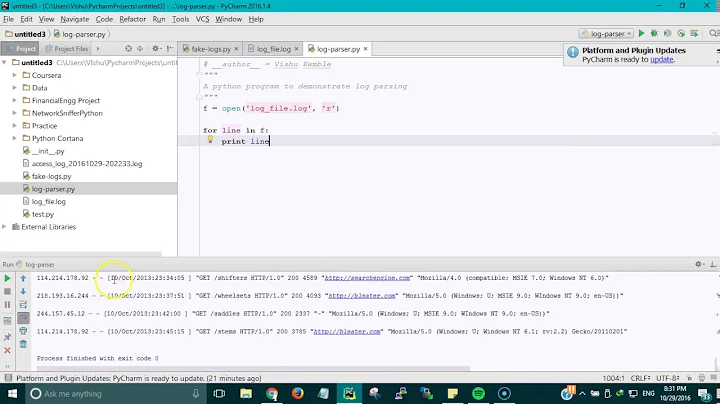How can I count instances of a regex match in a log file using PowerShell?
Solution 1
If you want to break out just the title portion (which I'm guessing you do) and not group based on the whole URL (which could contain information specific to that visit) you need to get the value of the title parameter like so:
get-content "test.txt" | % {if($_ -match 'title=([^\&]+)') {$($Matches[1])}} | group | sort -desc Count
Solution 2
This is off the top of my head but you should be able to do this with a one-liner.
You can either shove it in a variable and get the length of that variable like so:
$count = get-content .\test.txt | select-string -pattern "AA000"
$count.length
Or our can just do it all inline by using parens:
(get-content .\test.txt | select-string -pattern "AA000").length
You can do you top count with the group-object cmdlet.
get-content .\test.txt | group-object | export-csv out.csv
That is pretty ugly right now, but you should be able to go from there
Related videos on Youtube
Pierson Leo
Updated on September 18, 2022Comments
-
Pierson Leo over 1 year
I have a receiver that plays audio when phone screen is turned on or off.
I send the audio file to the receiver like this
try { Intent i = new Intent("my.action"); i.putExtra("posLock", newPosition2).putExtra("songlistLock", mySongs).putExtra("lockSound", "lock"); sendBroadcast(i); }catch (Exception e) { Log.e(TAG, "Intent error"); }and
try { Intent i = new Intent("my.action.unlock"); i.putExtra("posUnlock", newPosition3).putExtra("songlistUnlock", mySongs).putExtra("unlockSound", "unlock"); sendBroadcast(i); }catch (Exception e) { Log.e(TAG, "Intent error2"); }Then I play the audio on my receiver class
LockScreenReceiver.java
public class LockScreenReceiver extends BroadcastReceiver { MediaPlayer mp; ArrayList<File> mySongs; ArrayList<File> mySongs2; Uri u; Uri u2; AudioManager am; private static final String TAG = SecondScreen.class.getSimpleName(); @Override public void onReceive(Context context, Intent intent) { String action = intent.getAction(); am = (AudioManager)context.getSystemService(Context.AUDIO_SERVICE); if(action.equals("my.action")) { Bundle b = intent.getExtras(); mySongs = (ArrayList) b.getParcelableArrayList("songlistLock"); int position = b.getInt("posLock", 0); u = Uri.parse(mySongs.get(position).toString()); } if(action.equals("my.action.unlock")) { Bundle b = intent.getExtras(); mySongs2 = (ArrayList) b.getParcelableArrayList("songlistUnlock"); int position = b.getInt("posUnlock", 0); u2 = Uri.parse(mySongs2.get(position).toString()); } if (action.equals(Intent.ACTION_SCREEN_ON) && am.getRingerMode() == AudioManager.RINGER_MODE_NORMAL) { if(u2!=null) { stopPlaying(); mp = MediaPlayer.create(context, u2); mp.start(); Toast.makeText(context, "Audio on playing", Toast.LENGTH_SHORT).show(); } } else if (action.equals(Intent.ACTION_SCREEN_OFF) && am.getRingerMode() == AudioManager.RINGER_MODE_NORMAL) { if(u!=null) { stopPlaying(); mp = MediaPlayer.create(context, u); mp.start(); Toast.makeText(context, "Audio off playing", Toast.LENGTH_SHORT).show(); } } } private void stopPlaying() { if (mp != null) { mp.stop(); mp.release(); mp = null; } } }And I register my receiver using service
LockScreenService.java
public class LockScreenService extends Service { BroadcastReceiver receiver; @Override public IBinder onBind(Intent intent) { return null; } @Override @SuppressWarnings("deprecation") public void onCreate() { //Start listening for the Screen On, Screen Off, and Boot completed actions IntentFilter filter = new IntentFilter(Intent.ACTION_SCREEN_ON); filter.addAction(Intent.ACTION_SCREEN_OFF); filter.addAction(Intent.ACTION_BOOT_COMPLETED); //Set up a receiver to listen for the Intents in this Service receiver = new LockScreenReceiver(); registerReceiver(receiver, filter); registerReceiver( receiver, new IntentFilter( "my.action" ) ); registerReceiver( receiver, new IntentFilter( "my.action.unlock" ) ); // Toast.makeText(getApplicationContext(), "Starting service now", Toast.LENGTH_SHORT).show(); super.onCreate(); } @Override public int onStartCommand(Intent intent, int flags, int startId) { return START_STICKY; } @Override public void onDestroy() { unregisterReceiver(receiver); super.onDestroy(); } }And I also register my receiver in my Manifest.xml
Manifest.xml
<receiver android:name=".LockScreenReceiver" android:enabled="true"> <intent-filter> <action android:name="android.intent.action.BOOT_COMPLETED" /> <action android:name="my.action" /> <action android:name="my.action.unlock" /> </intent-filter> </receiver>From what I read, when receiver is registered through the manifest, it should keep on running even after the app is terminated. But when I test it, my phone stops playing the audio after I closed my app from the recent apps manager.
-
Scott Keck-Warren over 12 yearsIs the log file delimited in some way (tab, csv, etc.)?
-
TZttt over 12 yearsNope. The part I'm trying to parse out is in the middle of very long URLs as a parameter (&Title=AA000####).
-
 Deividi Cavarzan over 8 yearsYou should implement
Deividi Cavarzan over 8 yearsYou should implementonStartCommandand return the flag START_STICKY developer.android.com/intl/pt-br/reference/android/app/… -
Pierson Leo over 8 yearsI tried that before, but it doesn't work.
-
 Deividi Cavarzan over 8 yearsbecause your MediaPlayer object need to be in the service, not in the receiver
Deividi Cavarzan over 8 yearsbecause your MediaPlayer object need to be in the service, not in the receiver -
Pierson Leo over 8 yearsCan you post the code? Does that mean I should play the audio from the service instead of from the receiver?
-
 Deividi Cavarzan over 8 yearstake a look here: stackoverflow.com/questions/6668298/…
Deividi Cavarzan over 8 yearstake a look here: stackoverflow.com/questions/6668298/… -
Pierson Leo over 8 yearsWill it work If I make and play my MediaPlayer object in the service and send the player as an intent to the receiver? (so that it plays audio when phone screen is turned on or off)
-
-
TZttt over 12 yearsI need to count how many times a given AA000#### appears in the file. For example, how many times was item PX0001582 requested? What I'm really interested in is which items were requested the most times.
-
TZttt over 12 yearsThis worked GREAT. Thanks!! I learned something today :)
-
 Narendra talapara almost 8 yearsthis works fine in on 4.4+ version i have added also
Narendra talapara almost 8 yearsthis works fine in on 4.4+ version i have added also -
psantiago over 6 yearsOne thing to keep in mind is also piping to format-table autosize (
| ft -autosize) in the event of your counts being large enough to where powershell ellipses the output.




